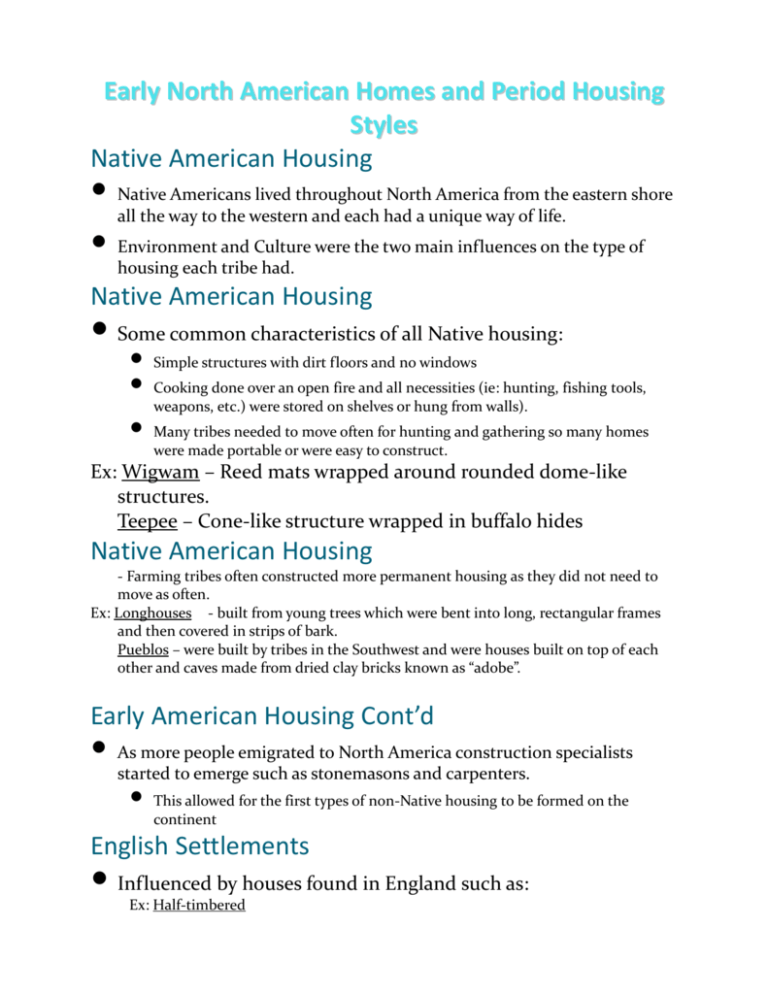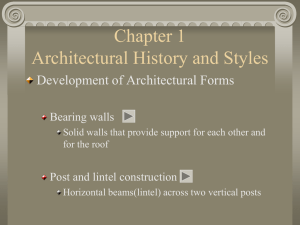2a. Early North American Homes and Period Housing Styles
advertisement

Early North American Homes and Period Housing Styles Native American Housing Native Americans lived throughout North America from the eastern shore all the way to the western and each had a unique way of life. Environment and Culture were the two main influences on the type of housing each tribe had. Native American Housing Some common characteristics of all Native housing: Simple structures with dirt floors and no windows Cooking done over an open fire and all necessities (ie: hunting, fishing tools, weapons, etc.) were stored on shelves or hung from walls). Many tribes needed to move often for hunting and gathering so many homes were made portable or were easy to construct. Ex: Wigwam – Reed mats wrapped around rounded dome-like structures. Teepee – Cone-like structure wrapped in buffalo hides Native American Housing - Farming tribes often constructed more permanent housing as they did not need to move as often. Ex: Longhouses - built from young trees which were bent into long, rectangular frames and then covered in strips of bark. Pueblos – were built by tribes in the Southwest and were houses built on top of each other and caves made from dried clay bricks known as “adobe”. Early American Housing Cont’d As more people emigrated to North America construction specialists started to emerge such as stonemasons and carpenters. This allowed for the first types of non-Native housing to be formed on the continent English Settlements Influenced by houses found in England such as: Ex: Half-timbered - The frame of house was visible in the walls and in between was filled with plaster or brick. Roofing used “thatch” (bundles of straw). - Some houses used wooden shingles to cover walls and roofs as well. English Settlements Cont’d Cape Cod - Simple rectangle design with a central chimney and pitched roof (two-sided roof with one steep angle). - These pitched roofs are often referred to as gable roofs as they form triangular end walls known as gables. - Gable roofs created very little useable space on 2nd floors which resulted in the creation of the gambrel roof which has two slopes on each side to allow for more useable space on 2nd floor. German Settlements German settlers built large, durable houses of wood and stone. Featured entry into a 1st floor kitchen and central chimney. Large family room for entertaining. Often had a small condensed roof between the 1st and 2nd floors known as a hood. Dutch Settlements Used stone and brick to construct quite large homes (some were 4 and 5 stories high). Featured very decorative brickwork and often used the “gambrel roof” style. To add light to rooms they often included dormers (structures built into a roof containing a “dormer window” to let in light). Often featured metal gutters and the Dutch door (a normal door divided in half so top and bottom could be opened separately). Swedish Settlements Are credited with the classic “log cabin” style that many know and love. Settlers were pushing westward into forest and logs were made useful in constructing homes by laying them horizontally on each other and connecting them with notched ends. Joints and cracks were filled with clay, bark and moss. Roof was originally made of “thatch” or bark with shingles being added later. Spanish Settlements Mostly established in Florida area Often constructed using coquina (a light, porous limestone made from coral and shells) Featured rectangular balconies facing street and separate kitchens to avoid heating the rest of the house. Later Spanish homes became more elaborate and were often made of stucco (plaster material made from cement, sand and lime). Featured rounded archways and windows with red tiles roofs and sometimes inner courtyards. French Settlements Established mainly along the St.Lawrence river and were built of stone or wood. Featured high, steep roofs, small windows and heavy wooden shutters which could open and close. When adapted for life in more southern areas like Mississippi they included a large porch covered by the roof to keep it cool and protect from rain. Houses were often raised on porches to protect from floods and combined with multiple windows helped to improve air flow. Later versions often included balconies as well. Period Housing Styles Period Styles Architectural history is often divided into periods to help explain the styles and features of housing during that time. Each period is not distinct and separate in nature but flows into other periods. 18th Century This period of housing occurred just after the Early North American Housing Styles previously discussed and contains many similar features. During the 18 th century 2 Period Housing styles emerged in North America: The Georgian Period The Federal Period Georgian Period Closely mirrored the popular Georgian style that was popular in England at the time. Features included: 2 – 3 stories high with a gabled roof or hip roof (roof with 4 sloped sides) Large paned windows and highly decorative doors framed with pilasters (decorative columns) and often topped with a pediment ( triangular arched decoration). Cornice – a decorative strip where roof and wall meets. A central chimney Federal Period After the American Revolution attitudes toward England changed and thus housing style was changed to be different from them. This period includes 2 main styles: Adam Style Early Classical Revival Style Adam Style Named after architects Robert and James Adams who combined elements of Georgian style with elements from classical Greece and Rome. Features include: A rectangular shape with one or more stories Gable roof with slopes facing front and back of house Windows symmetrically placed and a fanlight (semi-circular, round or oval window with fan shaped pieces of glass). These were often found above doors. Very decorative interiors such as carvings and large mantles near fireplaces. Early Classical Revival Style This style was very similar to the Adam Style in that it borrowed from classic Greek and Roman styles and contained many similar features. The main difference from the Adam style is that Early Classical Revival Styles is the inclusion of a portico. Portico – A tall, open porch, supported by columns over the front porch with a triangular pediment topping the columns. 19th Century The onset of the Industrial Revolution allowed for mass production of the products needed for home construction and an increase in immigrants. Home prices dropped during this period and more people were able to purchase. Factory workers were not so fortunate and could not afford housing so Tenements were built to house them. Tenements – apartment complexes with minimum levels of sanitation, safety, and comfort. Housing styles during this period varied greatly as people became wealthy. They had many ideas and wanted to see them come to life. Two periods emerged as the dominant ones: The Romantic Revival Period The Victorian Period The Romantic Revival Period With many writers, poets and artists finding inspiration in the writers of the past this Period takes much of its inspiration from ancient Greece, medieval Europe and Renaissance Italy. Three styles as a result of this were: Greek Revival Style Gothic Revival Style Italianate Style Greek Revival Style Features of this style were directly linked to the ancient Greek temples and included many of the following features: Two-story rectangular house with symmetric windows A gable roof Pilasters on the corners of the house or across the entire front Very elaborate, decorative doorways with glass finishes Columns used to support a porch Gothic Revival Style Borrowed from the European styles of the past and included: Pointed arches and circular windows with highly ornamented carved stone Many included very high peaked gothic gables with gingerbread (lacy-looking, cutout wood trim) Italianate Style Borrowed its style from the classic Italian villas. Features include: Square structure and usually two stories high Wide, overhanging hip roofs with decorative brackets or supports. Long narrow windows that were often arched and topped with an inverted U-shape. The Victorian Period Borrows its name from Queen Victoria of England and its style from the highly decorated and elaborate styles of medieval and Renaissance Europe. Two popular styles that came about during this period were: The Mansard Style The Queen Anne Style Mansard Style Influenced greatly by the French styles in Europe. Most notable feature of the Mansard style is the mansard roof. Mansard Roof - a boxlike roof with two slopes on all four sides. The lower slope was very steep with the upper slope (on top) being almost flat. Decorated cornices, long windows opening lengthwise at the middle (French Windows), and dormers were all common features of this style as well. Queen Anne Style Highly decorated and colored exterior and interiors were very evident in this style as wealth increased Typical features included: Irregular steep roof with ornamental gables and overlapping decorative shingles for siding. Wrap-around porches with railing and column supports. Often had a circular tower extending the height of the house. Highly decorative woodwork throughout 20th Century Two main styles came about during the 2oth century. The first was a revival of traditional styles and the second was based on entirely new ideas and was known as modern. Two variations of these styles emerged in the Early 2oth Century: Period Revival Styles Modern Styles Period Revival Styles These were taken directly from the past and were meant to channel the styles and features of houses from history. Included in this group are: Colonial Revival Style Tudor Style Chateauesque Style Mission Style Period Revival Styles Colonial Revival Styles – brought back the classic styles such as Georgian and Cape Cod and incorporated many of the same features. Tudor Style – Often borrowed from the earlier half-timbered styles. They often included large chimneys and tall narrow windows grouped together. Chateauesque Style – Used French palaces as inspiration and often included towers, turrets, elaborate moldings, and arched windows/doorways. Mission Style – Borrowed much of its style from the early Spanish settlements and included stucco as a main building material. Often contained arched doorways/windows, tile roofs and pyramid shaped roofs. Modern Styles Some architects did not want to look to the past for inspiration but instead wanted to create something completely new. From this inspiration came the modern style and include styles such as: Prairie Style Craftsman Style International Style Modern Styles Prairie Style – Emphasized horizontal lines, low pitched roofs with overhanging eaves, wide porches and rows of windows. Interiors were often open and spacious. Craftsman Style – shared many of its features with the Prairie style. One type of craftsman style is the common bungalow (a small, one story house with an overhanging roof and covered porch). International Style – emphasized functionality and thus contained very little decorative elements. Combined simple geometric shapes, with a flat roof and large expanses of windows. Mid-20th Century to Today After World War II most people wanted new “modern styles” and several styles emerged as a result. Two of these styles are: Postwar Modern Innovative Designs Postwar Modern Ignored historical influences and incorporated new, innovative ones. Included in these styles are: Ranch Style Contemporary Style Split-level Style Shed Style Postwar Modern Ranch Style – a long, low, one story house featuring a low-pitched gable or hip roof, decorative shutters and often contain enclosed patios or courtyards. Influenced by the Craftsman and Prairie styles. Contemporary Style – features wide eaves, flat/low pitched roofs, exposed supporting beams, a variety of contrasting wall materials and unusual placement of windows. Split-Level Style – was a modification of the ranch style home, sharing some of its features but with 3 levels connected by short flights of stairs. Shed Style – Features a roofline made from combinations of steeply pitched shed roofs (sloped at different angles and facing different directions). Exteriors are usually wood shingle and it contains very little ornamentation. Innovative Designs A-Frame – contains a gable roof which continues to ground level on both sides. Very easy to build as side walls are not necessary but interior space is strangely laid out as a result. Geodesic Dome – efficient home built from triangular frames joined to form a self-supporting roof and walls. Frame is often metal or plastic and covered by a flexible skin or rigid panels. Less materials are needed as a result which allows for low-cost, energy saving housing.






